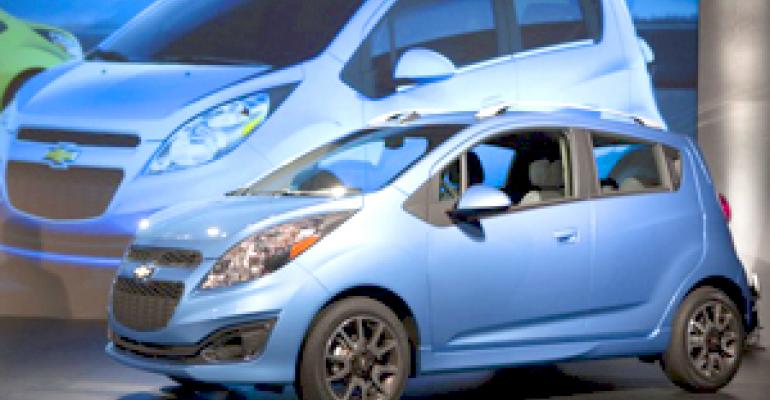
General Motors’ announcement Wednesday it will bring an electric version of the Chevrolet Spark minicar to the U.S. in 2013 has some industry observers wondering from where the vehicle will originate.
Some media are reporting the EV will come from South Korea, where gasoline- and diesel-powered Sparks currently are produced. If so, that’s news to the folks at GM Korea.
GM Korea does not have a prototype of the Spark EV, and “no location of production has been decided yet,” a spokesman tells WardsAuto. He also says there is no EV activity at the GM minicar production complex, located in Changwon, the sole source for the Spark.
Nor is there a Spark EV prototype at the main engineering and vehicle-production complex in Bupyeong, where GM Korea is headquartered.
The Korean subsidiary does have a demonstration fleet of 10 midsize Cruze EVs, but LG Chemical, the battery pack supplier, is in charge of their development and testing. GM Korea also has some Chevy Volts under test, but the extended-range plug-ins are a far cry from the diminutive, low-cost Spark.
GM said Wednesday the Spark EV will be powered by nanophosphate lithium-ion battery packs supplied by A123 Systems of Waltham, MA. A123 Systems has plants in Livonia and Ann Arbor, MI, and also operates facilities in Incheon, Korea, and in Shanghai and Changzhou, China.
GM says the Spark EV will draw from the auto maker’s experience with fleets of the Beat EV in India, the Sail EV in China and the Cruze EV in Korea. But there only is a single Spark EV prototype in India, where it is known as the Beat, and no operating fleet.
The Beat EV was shown in India in June, and Karl Slym, president and managing director of General Motors India, said at the time there were no production plans; that the electrified version was being displayed only to gauge consumer reaction.

Analysts say it’s unlikely a Beat EV would be of interest in India, because it would be too expensive to build and sell in the local market.
GM Korea says it worked with the Indian subsidiary to develop an “e-Beat” a year ago, but the project primarily was a joint undertaking between GM India and Reva Electric Car at the time.
The electrified car never got to the production stage, and GM India pulled out of the collaboration when Reva was sold to Mahindra & Mahindra in May 2010. The new company, Mahindra Reva Electric Vehicles, makes an EV called the Reva i, a 2-door, golf-cart-type hatchback that sells for about $7,500, but consumers have shown little interest.
That leaves the Sail EV in China, a concept vehicle developed by Shanghai GM and its Chinese partner SAIC at their jointly owned Pan Asia Technical Automotive Center.
The car was shown at the World Expo 2010 Shanghai auto show in April 2010 and at the Guangzhou auto show last December.
Some analysts wonder whether the Sail EV prototype will serve as the basis for the electrified car to be developed by Shanghai GM and SAIC. GM has said the new vehicle will not be retrofitted from a current production car.
General Motors Vice Chairman Steve Girsky and Tim Lee, president of GM International Operations, in announcing the new EV hookup with SAIC from China last month, said the car would be marketed in China first and then exported to other countries.
So will this be the car GM brings to the U.S. as an electrified Chevy Spark? Says a GM Korea spokesman when asked who is responsible for the coming EV: "It's being developed by the global corporation."





